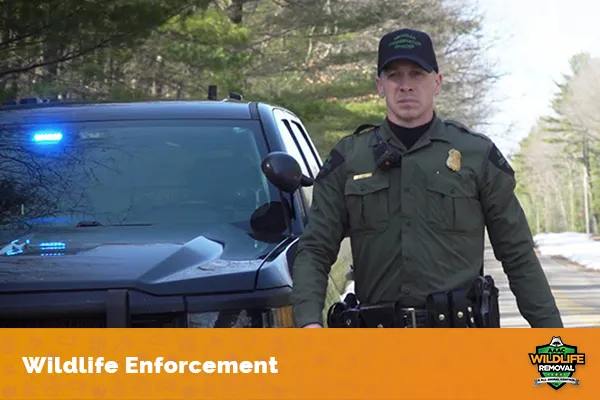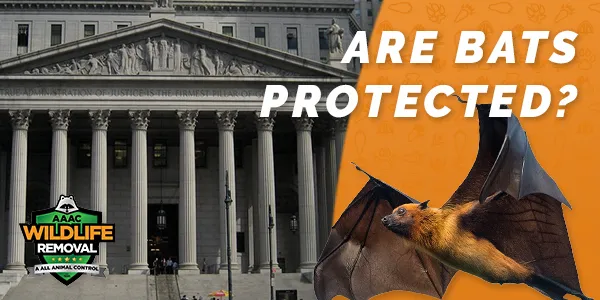Are bats protected? The simple answer is: YES
Most bats are protected by either state or federal law, and you will need to consult your local government or a qualified wildlife removal contractor to understand your options for removing bats.
This is the question many people ask when bats are found in their attic or roosting near a building. Bats may be considered nuisance pests in urban settings, however, bats are an important part of our ecosystem and are protected by Federal law. The fact is that bats play a valuable role in the ecosystem and are critical for pollination and insect control. Bats are also critical for agricultural production because they eat large quantities of insects that destroy crops. Unfortunately, their population is in decline due to habitat loss and white-nose syndrome
Bats provide vital pest control services. They are able to eat their own weight in mosquitoes in a single night! They also control the population of many other destructive insects that bring diseases that kill millions each year like malaria, yellow fever, West Nile virus, dengue fever, and others. They also pollinate plants and disperse seeds, allowing agriculture crops such as fruits and vegetables to grow.
Are bats a protected species?
Bats are considered threatened or endangered in some areas, so they are protected by law. They are endangered due to human activities such as deforestation, which has decreased the bats’ natural habitats. Some bat species are also threatened by water pollution and habitat destruction from urbanization or mining activities. White-nose syndrome has also played a huge part in the bat population decrease.
What are bat laws?
In the US, certain bat species are protected by the Federal Endangered Species Act of 1973 and the Fish and Wildlife Coordination Act of 1956. These laws provide protection for endangered bats, and their habitats and breeding grounds. Different states have different laws about what you’re allowed to do with a bat, but most agree that it is illegal to kill a protected species like bats without an exemption from the U.S. Fish and Wildlife Service or similar state agencies. Violating these laws can result in stiff penalties and fines.

Bats and the Law
Bats are protected by domestic and international legislation. In the US, while not all bat species are listed as endangered by the Federal Endangered Species Act of 1973 and the Fish and Wildlife Coordination Act of 1956, a number of individual state laws exist that offer protection to bats and their roosting habitats like caves and abandoned mines. These laws protect them and their habitats from disturbance, harm, and destruction, no matter what bats do to make themselves a nuisance. The laws also prohibit killing, injuring, or capturing any species of bats without a permit and these are rarely given and only under special circumstances, such as if the bat is rabid or poses a threat to humans.
There are also international laws that protect bats. For example, the U.K.’s Wildlife and Countryside Act was enacted to protect bats population and prohibits the willful destruction of or disturbance to any bat roost. Much like the U.S. Federal Endangered Species Act protects federally endangered species and their habitats in the US. The European Union also has regulations on the conservation of bats and other wildlife such as birds and mammals, It is called Council Directive 92/43 or Habitats Directive 1992. Furthermore, In Canada, the Convention on International Trade of Endangered Species (CITES) regulates trade to ensure that endangered species are not exploited or harmed by imports and exports.
Are bats endangered?
Sadly, bat population has greatly declined due to deforestation and white-nose syndrome, a devastating fungal disease affecting bat species populations all over the world. Bats only have one pup per year, so it is not easy to replenish their population. Extensive loss of habitat from urbanization, forest clearing, and commercial development is also at the root of population decline for some bat species. However, bat populations are slowly rebounding thanks to the cooperative efforts of conservationists, biologists, and researchers. This is why it is so important to control bats and not kill them.
Are all bats protected?
Unfortunately, not all bats are protected by these two US Federal laws. In fact, there are only six species under its protection – The Northern Long-Eared Bat, The Indiana Bat, The Grey Bat, The Florida Bonneted Bat, The Virginia Big-Eared Bat, and the Ozark Big-Eared Bat.
The majority of bats in North America are not federally protected. However, many state laws offer protection to some bat species or their habitats. It depends on where the bats live. For example, Texas’ bat protection law offers protections for endangered and threatened bat species within its borders. Other states may offer similar legal protections as well so it is important to consult a professional before doing anything with a wild animal.

Why are bats protected by law?
Bats are protected by law because their existence is threatened. Bats serve an important ecological function as well as natural services to humans like pest control assistance with agriculture crop production while simultaneously protecting human health through disease prevention. They also pollinate plants, disperse seeds over wide areas, and play a huge role in maintaining healthy tree populations . They pollinate fruit trees and spread seeds from one area to another, thereby ensuring the growth of new plant life.
They gobble up harmful insects like mosquitoes, which are carriers of diseases such as the Zika virus, West Nile virus, Malaria, and Dengue fever. Additionally, they help to reduce crop damage by eating many types of crop-destroying insects like corn earworm moths, beetles, cucumber beetle larvae, and other pests in the fields. However, bats carry diseases that can be harmful to humans, so it’s important to deal with infestations accordingly using bat abatement.
The importance of this role can’t be understated when you consider that a single bat can eat up to a third of its weight in insects. This translates to savings for farmers from reduced pesticide use as well as reduced environmental damage. A decline in bat population would certainly mean a huge increase in insect population and extinction to plants and trees that rely on bats for pollination. This will have a significant impact on the environment and the economy; as well as cause deaths due to various insect-borne illnesses.
Is it illegal to kill a bat?
It is illegal to kill a bat but some exceptions exist that allow for humane euthanization when necessary for human safety reasons. This might include eliminating them because they are infected with rabies or have injured people or pets. But most often this should be done by professional pest control specialists who can access hard-to-reach areas like attics and other structures without harming the bats in the process.
It is against the law in most states for people to willfully kill bats without an exemption from U.S Fish and Wildlife Service or similar state agencies. Violating these laws can result in stiff penalties and fines.

What can I do about bats in my attic?
People are often concerned about bats appearing in their homes and attics, which is not uncommon. Bats typically migrate to these areas during the colder months when it’s too cold outside for them. In some cases, people may even find a bat hibernating within an attic space or crawlspaces – These animals have been known to go into buildings with open windows on warm nights looking for shelter and warmth from the chilly outdoors.
In most cases, homeowners can take care of this problem without worrying because they will leave as soon as the weather warms up again so long as you keep exits clear by removing any obstructions that might block their way out while also sealing off openings where bats could enter your home during bat season. If you’re still worried, you can always call AAAC Wildlife Removal to take care of the problem for you. If you need us to clean up the bat poop in your attic, we are more than qualified to get the job done right.
If bats are present in your home or on your property year-round (even if there is no evidence of any harm) then they may be living somewhere near and entering through another opening like a chimney. This situation will require professional help from wildlife experts who have experience removing these animals without harming either wildlife or pets as well as other valuable structures.
Humane bat removal
It is important to remember that there are a variety of humane methods for removing bats from your attic or home. Bats can be captured by professionals who use nets, and other devices to capture them before relocating them within the same state.
The most important thing is not to panic when you see one of these animals in your home, they pose little risk if left alone; however, it’s always better to speak with animal experts as soon as possible about how best to proceed– especially if children live in the house too!
Bat Exclusion
A popular method to manage bats in the attic or on your property is by a process called bat exclusion. This technique typically involves sealing all access points and installing a one-way door – this will allow them to go out but not return once outside. In most cases, it may be necessary to install an area of mesh netting around any areas that have been identified as potential entrances for these animals. Remember: if you find evidence of them nesting indoors then contact professional wildlife experts immediately! For advice on how to effectively and humanely deal with these wild animals, call us today!

Originally published on https://aaacwildliferemoval.com/blog/bats/are-bats-protected-all-you-need-to-know



